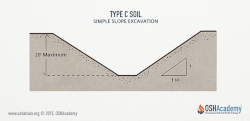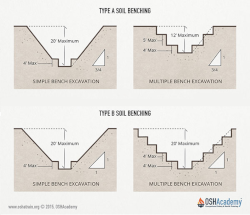Protective Systems
The basic methods for protection from cave-ins are sloping, benching, shoring, and shielding. The method you should use depends on factors such as soil type and water content, excavation depth and width, the nature of the work, and nearby activities that could increase the risk of a cave-in.
The competent person has the responsibility for considering these factors and for determining the appropriate protective system. A registered professional engineer must design protective systems for all excavations that are more than 20 feet deep.
Sloping
Sloping to protect workers can be done by cutting back the trench wall at an angle inclined away from the excavation not steeper than a height/depth ratio of 1.5:1, according to the sloping requirements for the type of soil.
- Always provide a way to exit a trench - such as a ladder, stairway or ramp - no more than 25 feet of lateral travel for employees in the trench.
- Keep spoils at least two feet back from the edge of a trench.
- Make sure that trenches are inspected by a competent person before entry and after any hazard-increasing event such as a rainstorm, vibrations or excessive surcharge loads.
- Maximum allowable slopes for excavations less than 20 ft. (6.09 m) based on soil type and angle to the horizontal are as shown in the image to the right.
Benching
Benching is a method of protecting workers from cave-ins by excavating the sides of an excavation to form one or a series of horizontal levels or steps, usually with vertical or near-vertical surfaces between levels.
- There are two basic types of benching, simple and multiple.
- Benching in type C soil requires a registered professional engineer.
Rain, vibration, and pressure from heavy equipment can make soil unstable and increase the risk of a cave-in.
- Sloped or benched excavations that show signs of cracks, bulges, or clumps of soil that fall away from the faces are dangerous and must be inspected by a competent person.
- You must immediately get out of the excavation and stay away until the competent person determines it is safe to enter.
Knowledge Check Choose the best answer for the question.
5-7. Which excavating practice protects workers from cave-ins by forming one or more horizontal levels or steps?
You forgot to answer the question!


